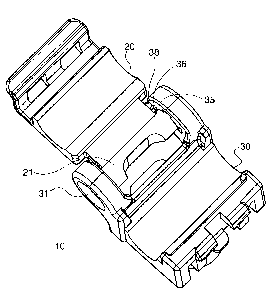Some of the information on this Web page has been provided by external sources. The Government of Canada is not responsible for the accuracy, reliability or currency of the information supplied by external sources. Users wishing to rely upon this information should consult directly with the source of the information. Content provided by external sources is not subject to official languages, privacy and accessibility requirements.
Any discrepancies in the text and image of the Claims and Abstract are due to differing posting times. Text of the Claims and Abstract are posted:
| (12) Patent Application: | (11) CA 2456805 |
|---|---|
| (54) English Title: | HINGE |
| (54) French Title: | CHARNIERE |
| Status: | Deemed Abandoned and Beyond the Period of Reinstatement - Pending Response to Notice of Disregarded Communication |
| (51) International Patent Classification (IPC): |
|
|---|---|
| (72) Inventors : |
|
| (73) Owners : |
|
| (71) Applicants : |
|
| (74) Agent: | OSLER, HOSKIN & HARCOURT LLP |
| (74) Associate agent: | |
| (45) Issued: | |
| (22) Filed Date: | 2004-02-03 |
| (41) Open to Public Inspection: | 2004-12-04 |
| Availability of licence: | N/A |
| Dedicated to the Public: | N/A |
| (25) Language of filing: | English |
| Patent Cooperation Treaty (PCT): | No |
|---|
| (30) Application Priority Data: | |||||||||
|---|---|---|---|---|---|---|---|---|---|
|
A hinged product has a first section arid a second
section. The first section has a post extending transversely
across one end thereof. The second section two co-axial
apertures therein, each of the apertures having an internal
wall. The post extends between and through the apertures to
connect the first section to the second section. The first
section is integrally formed with the second section via at
least one connection point connecting the first section and
the second section outside of the apertures. Rotating the
first section relative to the second section causes the
connection point to break and create a two piece hinge.
Note: Claims are shown in the official language in which they were submitted.
Note: Descriptions are shown in the official language in which they were submitted.

2024-08-01:As part of the Next Generation Patents (NGP) transition, the Canadian Patents Database (CPD) now contains a more detailed Event History, which replicates the Event Log of our new back-office solution.
Please note that "Inactive:" events refers to events no longer in use in our new back-office solution.
For a clearer understanding of the status of the application/patent presented on this page, the site Disclaimer , as well as the definitions for Patent , Event History , Maintenance Fee and Payment History should be consulted.
| Description | Date |
|---|---|
| Inactive: Agents merged | 2013-10-29 |
| Application Not Reinstated by Deadline | 2010-02-03 |
| Time Limit for Reversal Expired | 2010-02-03 |
| Deemed Abandoned - Failure to Respond to Maintenance Fee Notice | 2009-02-03 |
| Inactive: Abandon-RFE+Late fee unpaid-Correspondence sent | 2009-02-03 |
| Inactive: IPC from MCD | 2006-03-12 |
| Inactive: IPC from MCD | 2006-03-12 |
| Inactive: IPC from MCD | 2006-03-12 |
| Inactive: IPC from MCD | 2006-03-12 |
| Inactive: IPC from MCD | 2006-03-12 |
| Application Published (Open to Public Inspection) | 2004-12-04 |
| Inactive: Cover page published | 2004-12-03 |
| Inactive: IPC assigned | 2004-04-01 |
| Inactive: First IPC assigned | 2004-04-01 |
| Inactive: Filing certificate - No RFE (English) | 2004-03-10 |
| Filing Requirements Determined Compliant | 2004-03-10 |
| Application Received - Regular National | 2004-03-10 |
| Abandonment Date | Reason | Reinstatement Date |
|---|---|---|
| 2009-02-03 |
The last payment was received on 2008-01-17
Note : If the full payment has not been received on or before the date indicated, a further fee may be required which may be one of the following
Please refer to the CIPO Patent Fees web page to see all current fee amounts.
| Fee Type | Anniversary Year | Due Date | Paid Date |
|---|---|---|---|
| Application fee - standard | 2004-02-03 | ||
| MF (application, 2nd anniv.) - standard | 02 | 2006-02-03 | 2006-01-18 |
| MF (application, 3rd anniv.) - standard | 03 | 2007-02-05 | 2007-01-23 |
| MF (application, 4th anniv.) - standard | 04 | 2008-02-04 | 2008-01-17 |
Note: Records showing the ownership history in alphabetical order.
| Current Owners on Record |
|---|
| JOSEPH ANSCHER |
| Past Owners on Record |
|---|
| None |